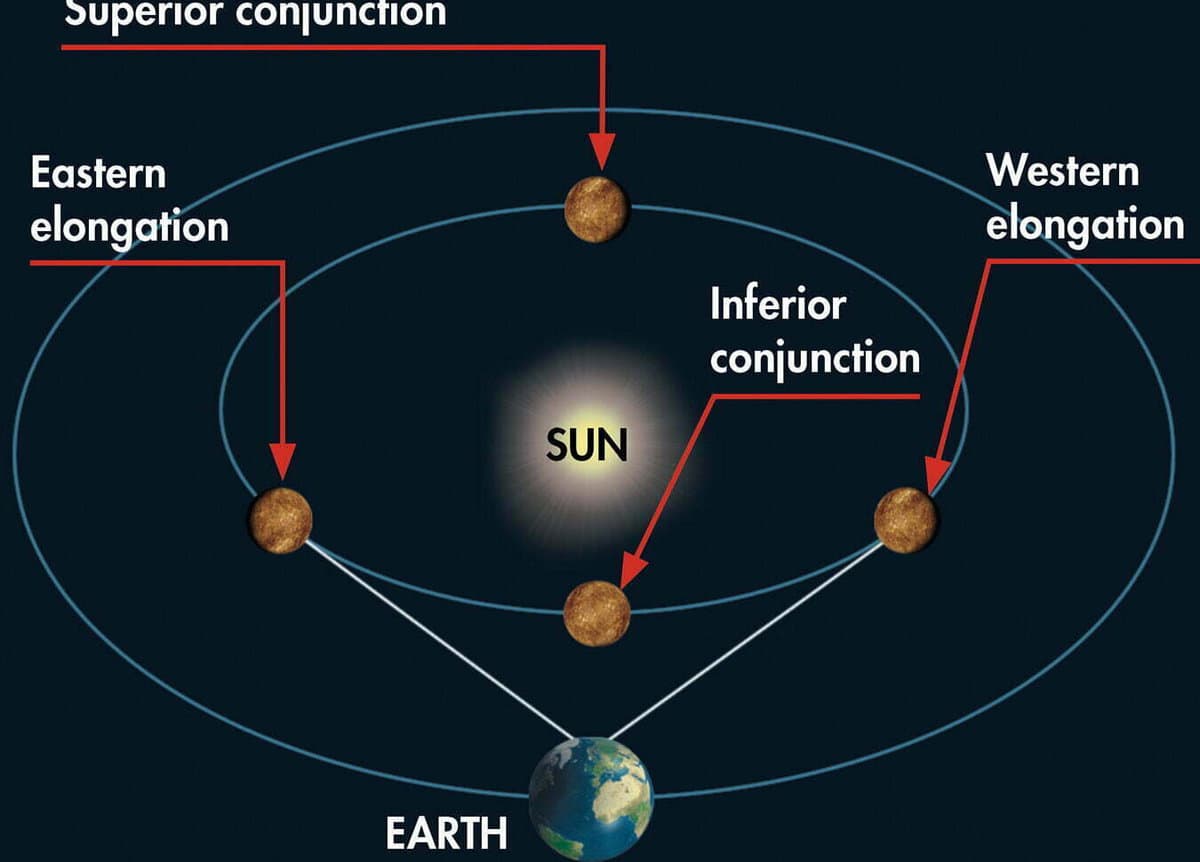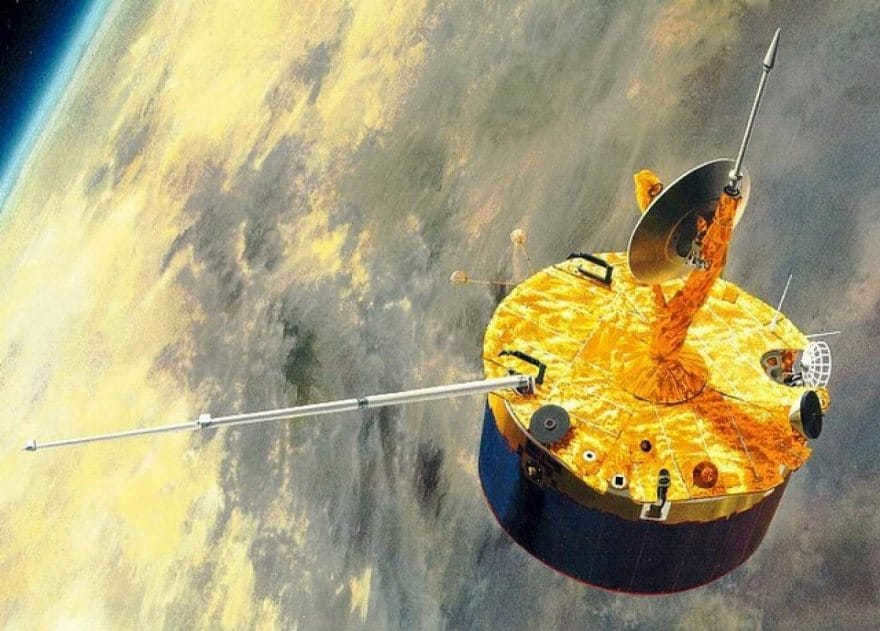
The Moon, Earth’s natural satellite, is the celestial body closest to us. It illuminates the night sky with reflected light, capturing the imagination of dreamers and poets. In terms of size, the Moon is quite substantial for a satellite. It has a radius of 0.273 times that of the Earth, equivalent to 1737 kilometers, and a mass of 7.3477-1022 kg, which is 0.0123 times the mass of the Earth.
Although the Moon possesses an atmosphere, it is incredibly thin compared to the Earth’s atmosphere and is unsuitable for breathing. As a result of the lack of atmosphere, the Moon’s surface is constantly bombarded by both large and small meteorites. The impact of these meteorites has a significant effect on the lunar topography, creating deep craters and depressions.
Distances to the nearest planet to Earth
The closest distance between Earth and Mars is 55.76 million kilometers, while the farthest distance is 401 million kilometers. As for Venus, the shortest possible distance from Earth is 38 million km, while the longest possible distance is 261 million km.
Venus is located at a distance of 108,200,000 km from the Sun, Earth is 149,600,000 km away, and Mars is 227,940,000 km away. In other words, if we imagine a star in one corner of the room, Venus would be just two steps away, while Pluto would be 100 steps away.
Venus
Venus, also known as the second planet from the sun, has some unique characteristics. One of the most interesting aspects of Venus is its retrograde rotation, which means it rotates on its axis in the opposite direction compared to most other planets. This retrograde motion sets Venus apart from the rest of the planets in our solar system.
Another remarkable feature of Venus is its dangerous atmosphere. The atmosphere of Venus is composed mainly of carbon dioxide and nitrogen. This dense atmosphere creates a greenhouse effect, trapping heat and causing the surface temperatures to rise significantly. In fact, the average surface temperature on Venus is a scorching 462°C, making it the hottest planet in our solar system.
Furthermore, the extreme conditions on Venus make it an inhospitable place for life as we know it. The high temperatures and the toxic atmosphere would destroy any probes or living organisms that attempt to explore or inhabit the planet.
Despite these harsh conditions, Venus shares some similarities with Earth. Both planets are almost identical in size, with Venus being only slightly smaller than Earth. This similarity in size has led scientists to compare Venus to a potential future for our planet.
With the increasing concerns about global warming on Earth, the extreme conditions on Venus serve as a warning. If the predictions of global warming come true and the Earth’s temperatures continue to rise, our planet could end up resembling Venus with its scorching temperatures and inhospitable environment.
In addition to its unique characteristics, Venus is also known for its volcanic activity. The surface of Venus is covered in volcanoes, which contribute to the planet’s dynamic geology. These volcanoes are a result of the intense heat and pressure within Venus, causing molten rock to erupt onto the surface.
Overall, Venus is a fascinating planet with its retrograde rotation, dangerous atmosphere, and volcanic activity. It serves as a reminder of the potential consequences of global warming and the importance of taking care of our own planet.
Red Planet
Mars, often referred to as the Red Planet, is a frigid desert with temperatures ranging from -87°C to -5°C. It is approximately half the size of Earth in terms of its dimensions. The planet’s thin atmosphere consists mainly of carbon dioxide and nitrogen, with a trace amount of argon. Scientists believe that Mars had liquid water approximately 3.5 billion years ago, as evidenced by the presence of ancient riverbeds and dried-up lake beds.
Planets of the Earth
Collectively with Mercury, all of these celestial bodies belong to the terrestrial group of planets. They are composed of a core, mantle, and crust. In addition to them, the Moon, our Earth’s satellite, is also examined.
Venus: Earth’s Nearest Neighbor
Nevertheless, the Moon cannot be regarded as Earth’s closest planet as it is not, strictly speaking, an independent celestial object. The closest planet to Earth is Venus, the second planet from the Sun in our solar system, which remains an enigma for astronomers and cosmologists.
Venus has a unique rotation compared to Earth and other planets. While most planets rotate clockwise around the Sun, Venus rotates in the opposite direction, known as retrograde rotation. Additionally, Venus rotates on its axis differently than Earth. Instead of standing upright, Venus “lies on its side” with its rotation axis lying in the same plane as its orbit, rather than being perpendicular to it.
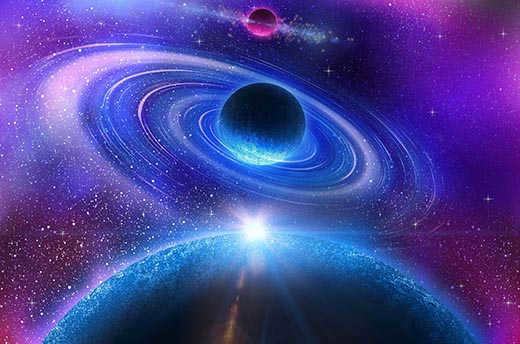
The unique characteristics of Venus resulted in the formation of incredibly long days on the planet, which last for approximately four months on Earth, equivalent to 116.8 Earth days. A complete revolution around the Sun, known as a Venusian year, takes about 224.7 days.
Venus shares many similarities with Earth in terms of size, as its diameter is 95% that of Earth and its mass is 81% that of Earth. However, the atmosphere on Venus is significantly denser, with an average pressure of approximately 90 times that of Earth’s atmosphere, and in certain regions, it can reach up to 119 times Earth’s atmospheric pressure.
The composition of the Venusian atmosphere is also distinct, consisting primarily of carbon dioxide with small amounts of nitrogen, oxygen, argon, and other gases.
Because of the dense atmosphere, the surface temperature of Venus is extremely high, reaching up to 480 degrees Celsius. This is primarily a result of the thick and heavy cloud cover that constantly surrounds the planet. Without these clouds, the surface temperature could potentially be lower by 400 degrees Celsius.
The presence of clouds obstructs our ability to observe and study the surface of Venus using telescopes and other astronomical instruments. Despite being the closest planet to Earth, our knowledge of the conditions and events occurring on its surface is extremely limited.
The closest planet to Earth is Venus and its orbit
Venus is situated at a distance of 108,208,000 kilometers from our Sun. However, this distance is not fixed and can range from 107,477,000 km (perihelion) to 108,939,000 km (aphelion), depending on its orbital path. It is interesting to note that the difference between these distances is quite small, indicating that Venus follows an almost circular orbit with an eccentricity of less than 0.01.
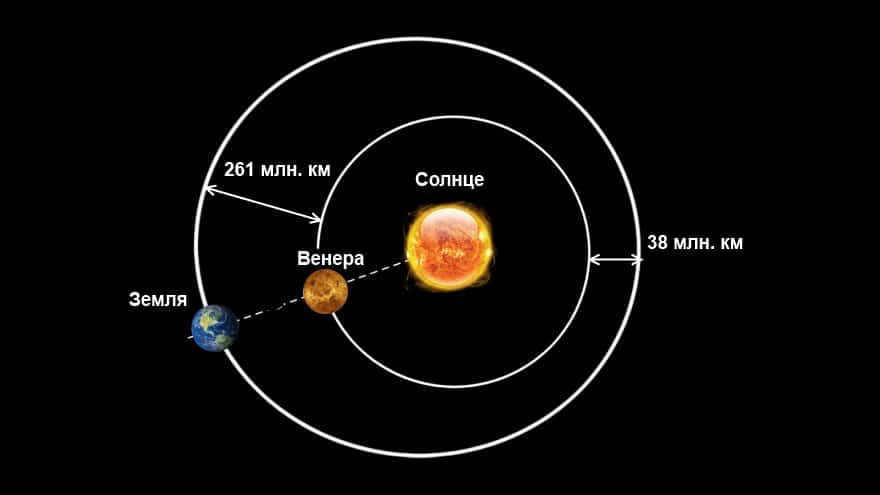
The orbit of Venus is located between the orbits of Mercury and Earth.
The distance from Earth to Venus varies depending on their positions in their respective orbits. The closest approach between Earth and Venus occurs when Venus is positioned between Earth and the Sun, which is approximately 41 million km. This close approach happens approximately every 584 days. However, the distance can change due to the varying eccentricity of Earth’s orbit.
Research on Earth’s Nearest Planet
Indeed, Venus is in proximity to us; however, investigating it presents numerous obstacles. The thick layer of atmosphere prohibits direct visual observation. The surface can only be observed through the use of radar imaging and the landing of various vehicles.
The initial endeavors were made by the USSR during the 1960s. In 1963, the Venera-3 successfully landed on the planet’s surface. This was followed by a series of probes, but the longest recorded survival time in the harsh conditions was 127 minutes.

The Venera-13 probe successfully captured the first color images of Venus’ surface.
In 1962, NASA used the Mariner probe for their missions. The second attempt was a success, with the probe flying over Venus at a distance of 34,833 kilometers. In the late 1970s, the USSR sent their own scouts to Venus, who gathered valuable information and even took pictures during their short stay on the planet. At the same time, the USA utilized the Pioneer spacecraft for their exploration.
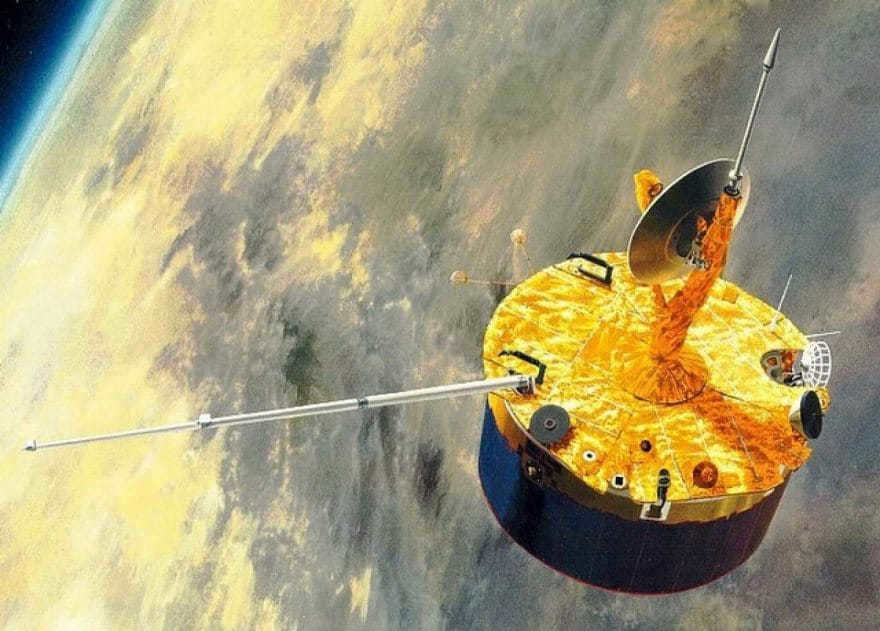
An artistic depiction of the Pioneer orbiter by NASA
In 1985, the Soviet Union joined forces with European scientists for the Vega program, which aimed to observe the flyby of Halley’s Comet and explore Venus. The spacecraft were released into Venus’ atmosphere to collect data on weather conditions.
In 1989, the Magellan mission embarked on a journey to Venus equipped with radar technology. It spent 4.5 years in orbit, meticulously mapping 98% of the planet’s surface and 95% of its gravity field. Eventually, it was intentionally sent into the atmosphere to gather density data before meeting its demise.
Galileo and Cassini both made observations of Venus as they passed by the planet. In 2007, the MESSENGER spacecraft also collected data on its way to Mercury. The Venus Express probe, launched in 2006, monitored the planet’s atmosphere and clouds until 2014.
In 2010, Japan’s JAXA sent the Akatsuki probe to Venus, but unfortunately, it was unable to reach orbit. Despite being relatively close to Earth, Venus is not a welcoming place for human exploration. However, NASA, Roscosmos, and India’s ISRO have plans for future joint missions to the planet.
Ambiance like no other
The Soviet Union’s missions in the mid-60s of the 20th century took a significant leap in exploration. The initial spacecraft couldn’t even make it there. It wasn’t until 1967 that the Venus 4 was able to uncover the secrets of our closest celestial neighbor. Despite being crushed by the immense atmospheric pressure, it provided invaluable data on the planet’s temperature and chemical composition. Venus is composed of 96% carbon dioxide, with nitrogen making up over 3% along with traces of sulfur, water, argon, neon, and helium. Just recently, scientists detected the presence of ozone at an altitude of 100 kilometers.
The Earth’s upper atmosphere is highly dense, similar to a layer found in water at a depth of 900 meters. This dense layer is composed of clouds of sulfur dioxide gas and sulfuric acid, reaching a height of sixty kilometers and enveloping the planet. These clouds have the remarkable ability to reflect back into space up to 60% of the sunlight that is meant to reach the Earth’s surface. Unfortunately, the combination of record levels of carbon dioxide and sulfuric acid has transformed our closest celestial neighbor into a blazing fireball. The greenhouse effect caused by these gases has resulted in record-breaking temperatures on the planet, with an average of 467°C. As a result, Venus is not only the hottest planet in our solar system, but also the second hottest celestial body after the Sun. Unlike Earth, the temperature on Venus remains consistent throughout the day and night.
At high altitudes, the red-hot ball creates a whirlwind-like effect, with the entire atmosphere rotating around it at speeds ranging from 120 to 140 meters per second. The extreme conditions, including toxic gases, high pressures, and the intense heat from its proximity to the Sun, have made it impossible for humans to ever step foot on the scorching surface.
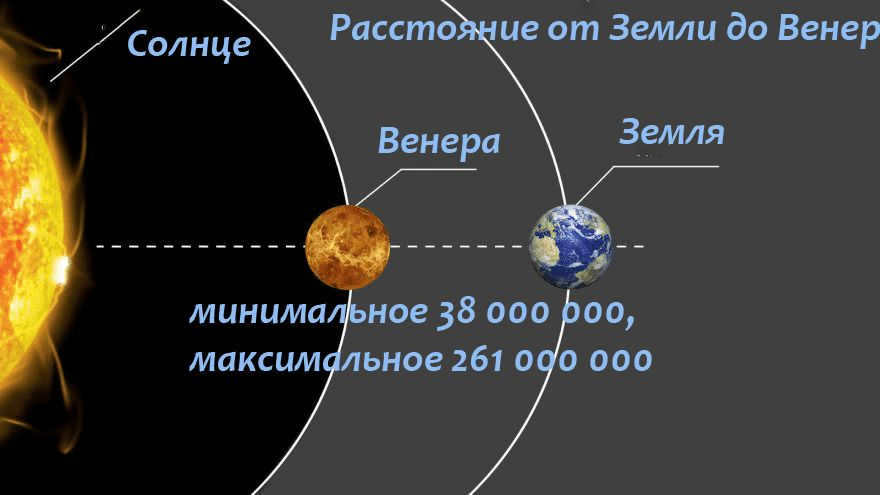
Distance between Earth and Venus.
A hostile goddess
Astronomers have been perplexed by these investigations. Until recently, no one knew what was concealed by the serene and constant light. The object could only be studied using radar. In 1997, the Geological Survey of America created a comprehensive map of its surface. Venus, the planet closest to Earth, is completely devoid of water. Scientists speculate that it once had water, but it gradually evaporated, leaving behind vast basins carved by long channels of volcanic lava.
Over 160 massive volcanoes have been discovered on the Venusian surface, with some of them being incredibly large, spanning over 100 kilometers. Research has confirmed that these volcanoes are actively erupting and releasing lava. Due to the lack of typical rainfall on Venus, it is believed that the thunderstorms in its atmosphere play a role in the formation of these volcanoes.
Using mathematical calculations to determine the sizes of the elevations, astronomers have discovered two continents on Venus: Ishtar and Aphrodite. Each continent is home to impressive landmarks. Ishtar is home to the tallest peak on the planet, Mount Maxwell, which reaches a height of eleven kilometers. Meanwhile, Aphrodite is home to the majestic Maat volcano.
The Magellan spacecraft, which is American, conducted research and found that none of the craters on Venus have a diameter larger than 2,000 kilometers. This suggests that smaller meteorites are unable to survive the extreme conditions of Venus’ atmosphere and burn up upon entry. The largest crater discovered so far covers an area of 30 kilometers. Additionally, researchers agree that there are no large potholes on Venus, indicating that the planet is relatively young in comparison to Earth.
Earth’s Twin
Through careful observations, scientists have discovered that Venus shares many similarities with our home planet. From its composition and structure to its mass, size, and density, Venus has been dubbed Earth’s sister. The only noticeable difference between the two is a mere 638 kilometers in diameter. The planet closest to Earth is comprised of a solid core that stretches six kilometers in length, enveloped by a thick mantle that extends over 3,000 kilometers as a molten, viscous substance. The outermost layer, the crust, is the thinnest, reaching a depth of 30 kilometers, mirroring its Earth-like sibling.
However, the scientific community remains divided on whether Venus possesses a solid or liquid core. The answer to this question remains elusive. Some experts argue for a liquid core, similar to that of Earth, while others propose the opposite. Notably, Venus lacks a magnetic field, which is typically generated by a liquid core. This further fuels the debate on the nature of Venus’ core.
Unlike Uranus, Jupiter, and Saturn, Mars is unique in that it has a high density. It belongs to the group of rocky objects in our solar system, with solid and rocky surfaces.
Could life exist on Mars and Venus?
One notable characteristic of Venus and Mars is their slow rotation. Venus, in particular, has an extremely slow rotation around its axis, with a day lasting as long as a year on Earth.
Despite their differences and their proximity to Earth, the chances of life existing on Mars and Venus are currently very low. Venus experiences average temperatures exceeding 400 degrees Celsius, while Mars has an average temperature of -80 degrees Celsius. Interestingly, on the Red Planet, temperatures can drop as low as -150 degrees Celsius in the region of the North Pole, while reaching -50 degrees Celsius on the Equator.
Despite the immense thickness of the ice, there is potential for life to thrive in this environment. This is due to the discovery of microorganisms in the extensive permafrost of thick ice on Earth, even in the northernmost regions such as the North Pole. These microorganisms have proven their ability to survive in sub-zero temperatures, suggesting that similar life forms may exist in this icy expanse.
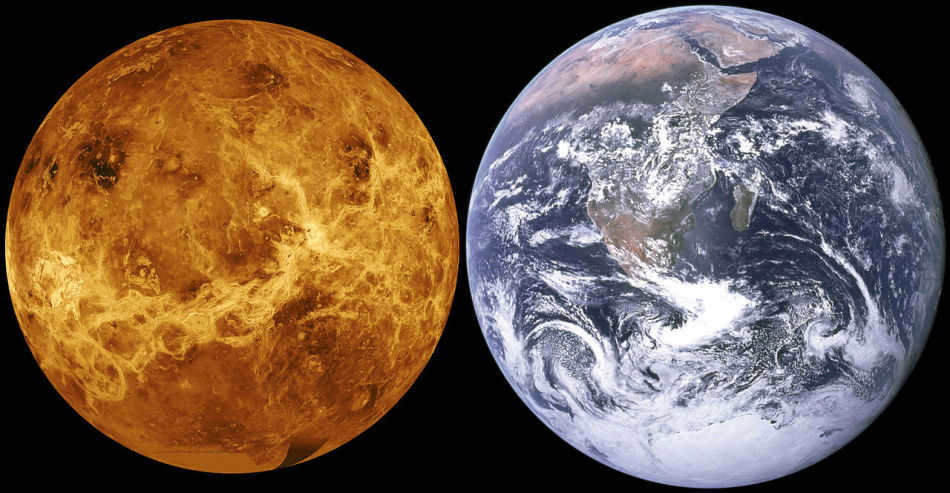
Earth and Venus
Currently, the orbits of Venus and Mars are not conducive to supporting life as we know it on Earth. This is mainly due to the aggressive atmospheres found on these planets. Venus, in particular, has extremely high temperatures and its air is saturated with inhospitable substances. On the other hand, Mars lacks sufficient oxygen and experiences low temperatures.
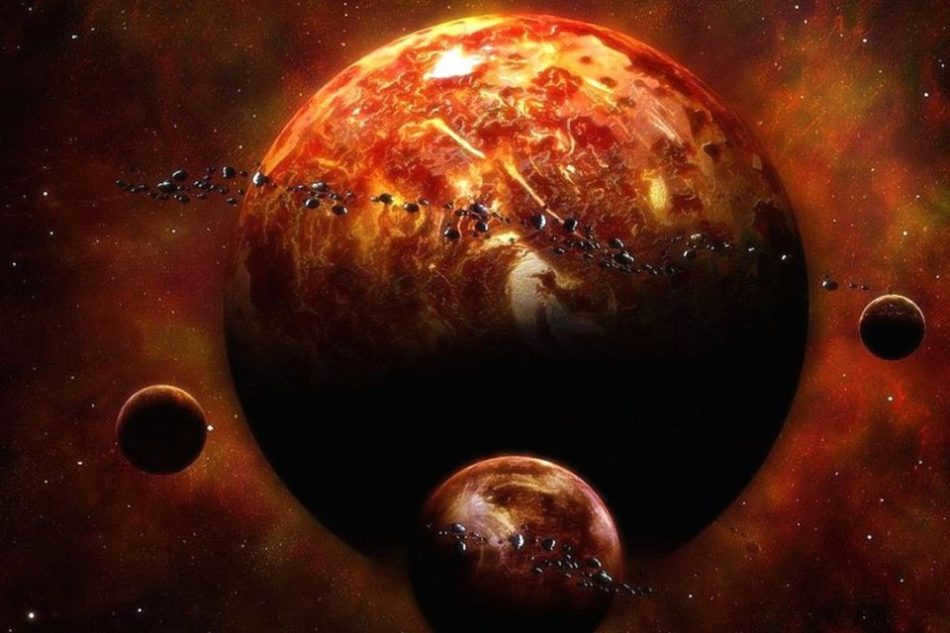
Venus
At present, the planets within the Earth group and those located in the vicinity of the solar system have been sufficiently explored by scientists. Given that the likelihood of life on the nearest planets is low, the search is now focused on exoplanets that have the potential to sustain life. However, these exoplanets are located at considerable distances from the solar system, making it nearly impossible to reach them. Perhaps in the course of several millennia, our descendants will have the capability to voyage to one of these exoplanets and establish friendly relations with their inhabitants.
The nearest planet in a different solar system
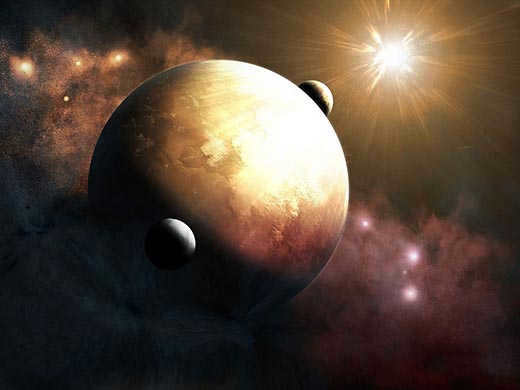
In the not too distant past, scientists came across the nearest exoplanet from a different solar system to our own. It lies approximately 33 light-years away and revolves around a red dwarf known as GJ 436.
With a diameter around two-thirds that of Earth and a mass roughly 30% of our own, this planet resides in a tight orbit around its star, completing a full revolution in just 35 hours. The surface temperature exceeds a scorching 600 degrees Celsius.
Scientists have reason to believe that this is not the sole planet in the system. It is possible that there is a slightly smaller companion also orbiting the same star.
VIDEO: Nearby Planets to Earth
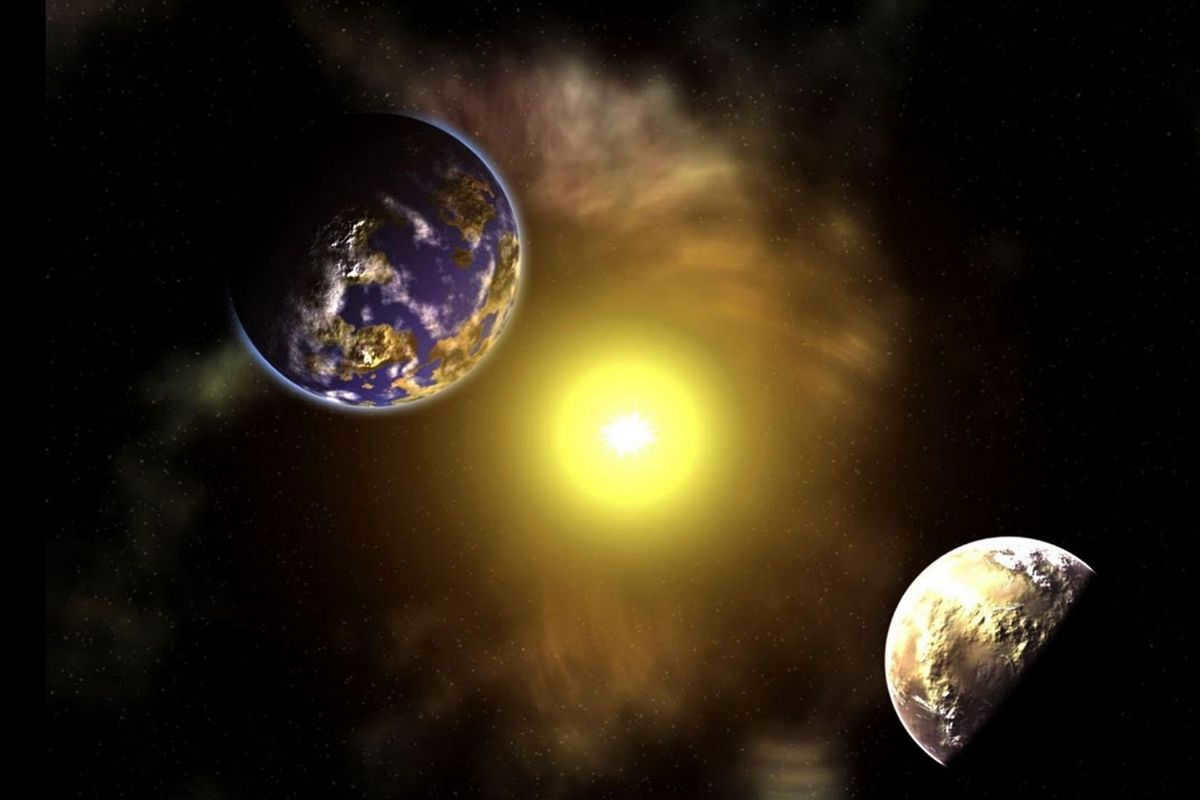
There exists a duplicate of the Earth, a perfect replica. And it is not situated somewhere far away in the vastness of space, but rather right in our own solar system. This has been confidently asserted by a group of enthusiasts led by Kirill Butusov, an astrophysicist, professor at St. Petersburg State University, and a member of the International Association of Planetologists, since the late 1990s.
The copy has been named “Gloria” by Kirill Pavlovich, although it was originally referred to as “Anti-Earth”. In response to the inquiry regarding the invisibility of Gloria, he clarified that it occupies the same orbit as Earth, traveling at the same velocity, but is positioned on the opposite side of the Sun – directly across from our planet. Consequently, it remains concealed from view as the Sun acts as an obstruction.
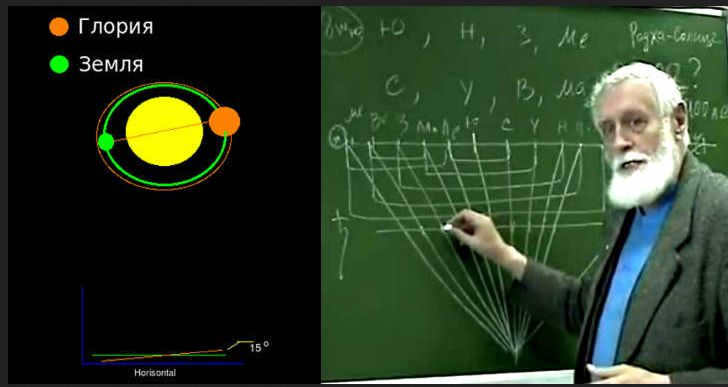

I am determined to find it
For nearly thirty years, there has been a daring, some might say insane, hypothesis that has gained popularity worldwide and garnered millions of supporters. However, it was only recently, though not completely, but fundamentally, confirmed. Astronomers from a large international team, working at the European Southern Observatory in Chile (The European Southern Observatory – ESO), have obtained clear evidence. The observatory has made this announcement in a press release.
– According to Olga Balsalobre-Ruza, an astrophysicist from the Center for Astrobiology in Spain, it is theoretically possible for two planets of equal mass to exist in the same orbit around their star. However, this phenomenon has never been observed before, making it a unique discovery.
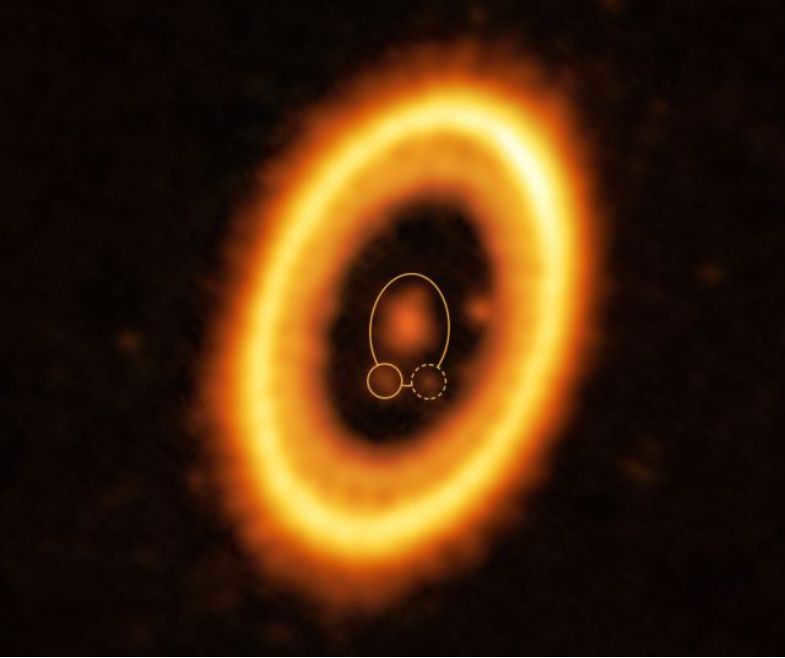
Scientists have captured an image of the PDS-70 star system, which is located 370 light years away from us. In this star system, there are two planets named PDS-70b and PDS-70c. Recently, a third planet has been discovered in the same orbit as PDS-70b.
These planets are relatively young and may still be in the process of formation. However, they are not just hypothetical, but real and observable. They orbit at similar speeds, although they are not exactly on opposite sides of their star. This arrangement may change in the future.
What’s even more interesting is that the newly detected planet, known as the anti-PDS-70b, is located at one of the Lagrangian points in its system, specifically at point L5. This point is where the gravitational interaction between the planet and its antiplanet is minimal.
According to Butusov, there is a possibility of an anti-Earth being located at the L5 point of the Earth-Sun system, although it was previously situated at the L3 point, which is on the opposite side of the Sun.
Just for your information: the Earth-Sun system has five Lagrange points, which are named after the mathematician who calculated their coordinates. These points are where the gravitational forces between the Sun and our planet are balanced.
Therefore, the observations indicate that these two planets could potentially coexist in the same orbit. It’s like they are kin. This confirms the Gloria hypothesis, albeit in an indirect manner.
Comrades in logic, thus you are in close proximity
Incidentally, counterparts of the Sun, Earth, and Anti-Earth can be found in closer proximity than PDS-70, albeit on a significantly smaller scale. Enter the Saturn system. If one envisions the gas giant as the Sun, and the major moons as planets, it becomes apparent that two of them share the same orbit but are positioned on opposite sides of Saturn – Epimetheus and Janus.

Gloria was spotted multiple times peering out from behind the Sun. Kirill Butusov theorized that it was an unidentified celestial body located near Venus, which was mentioned in the writings of European astronomers from the past such as Giovanni Cassini, James Short, Johann Mayer, and Joseph Louis Lagrange.
It appears that the ancient Egyptians had some knowledge of a planet similar to Earth. A panel in the tomb of Ramses VI in the Valley of the Kings depicts the Sun (depicted as the Sun God) and two identical planets on either side of it.
Gloria reveals itself from time to time through its subtle impact on its neighboring planets – Venus unexpectedly starts mysteriously accelerating, while Mars begins to slow down. Or it can be the other way around, defying all calculations. However, once Gloria is taken into account, everything falls into perfect alignment.
What’s even more fascinating is that the validation of the anti-Earth theory lends credence to the existence of extraterrestrial beings. Yes, aliens do exist. And all the tales about them hold true.
After all, it is possible that our copy may be inhabited – its location under the Sun is just as good as ours. And there could be intelligent beings living there. If this is the case, then the extraterrestrials are close to us, not somewhere in the distant horizon, unreachable even in a thousand years. They cannot reach us, and we cannot reach them. Perhaps the Glorians or anti-Earthlings have been observing us for a long time, as the ufologists claim. Why? It doesn’t require supernatural technology to travel around the sun. And we have the capability to do it as well. If we so desired.
As for the level of advancement our closest counterparts in intelligence have achieved, what they might look like, and whether the authorities or at least secret services are in contact with them, we will not speculate. There are numerous possibilities.
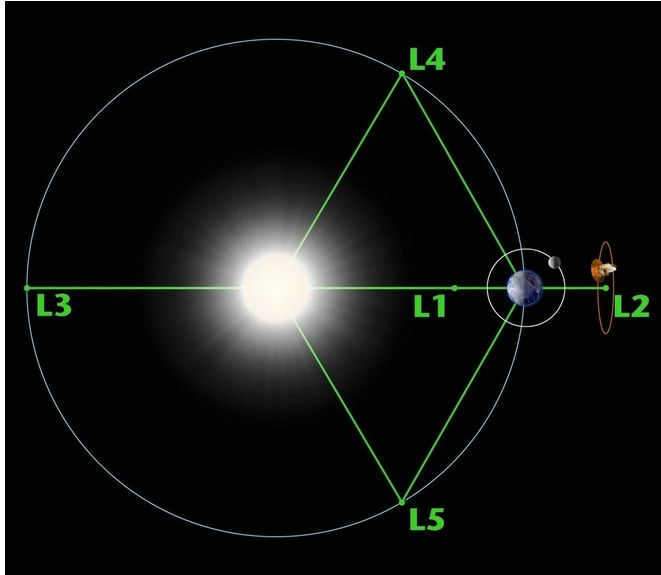
DOUBTS FROM SKEPTICS
Invisible while flying
No spacecraft sent into deep space has ever captured an image of Gloria. There are no photographs.
There is nothing suspicious – in terms of unidentified large celestial objects – in the images transmitted by the STEREO, SOHO, SDO space observatories that monitor the Sun.
Gloria remains unseen even in the James Webb Space Telescope (JWST) pictures taken from Lagrange point L2.
Arguments from Enthusiasts
You missed it
No spacecraft has ever directed its cameras towards the Lagrangian point L3.
The space observatories STEREO, SOHO, SDO, focus on the Sun, not what lies beyond it.
The L3 point cannot be observed from the James Webb Telescope’s L2 Lagrangian point.
Butusov’s calculations suggest that Gloria can be spotted from a distance that is 15 times greater than the distance from the Earth to the Moon. However, this is only possible if you know where to search.
Also Read
The site is intended for individuals over the age of 18.
This website is registered with Roskomnadzor, certificate El No. FS77-80505 dated March 15, 2021.
Olesya Nosova is the Editor-in-Chief.
Viktor Kanskiy is the Editor-in-Chief of the website.
The author of the current version of the publication is Vladimir Nikolaevich Sungorkin.
Readers’ messages and comments are published without prior editing. The editorial board reserves the right to remove or edit them if they are deemed to be an abuse of freedom of mass information or a violation of other legal requirements.
Komsomolskaya Pravda Publishing House JSC. Taxpayer Identification Number: 7714037217. Primary State Registration Number: 1027739295781. Address: 127015, Moscow, Novodmitrovskaya d. 2B. Telephone: +7 (495) 777-02-82.

